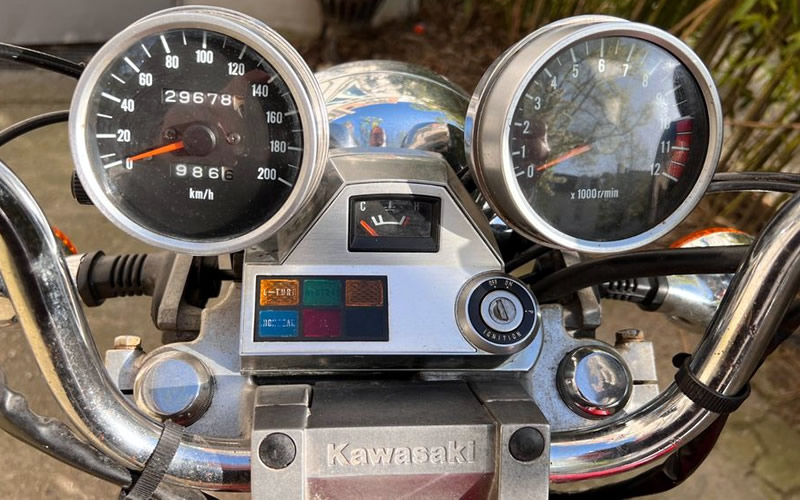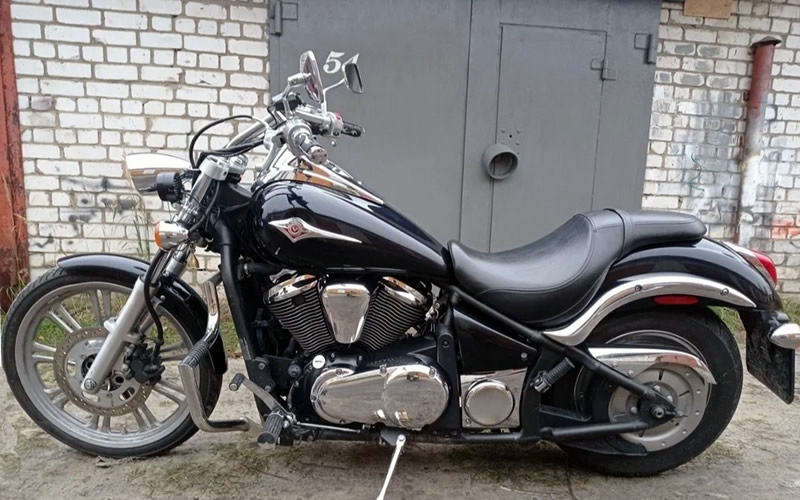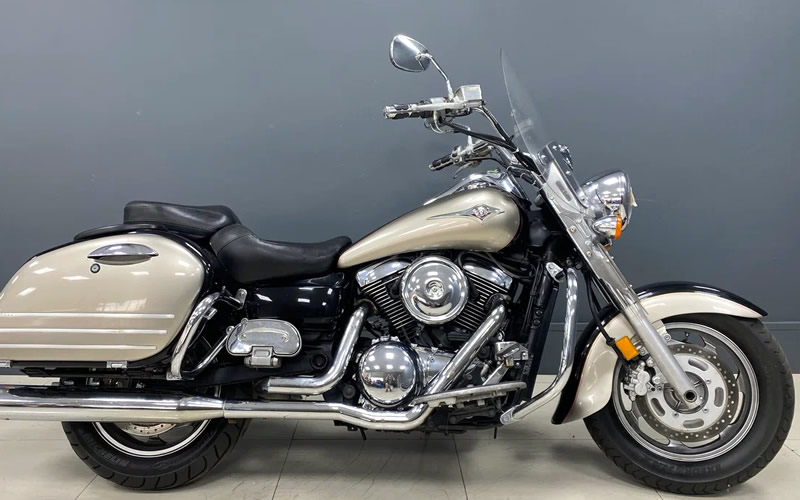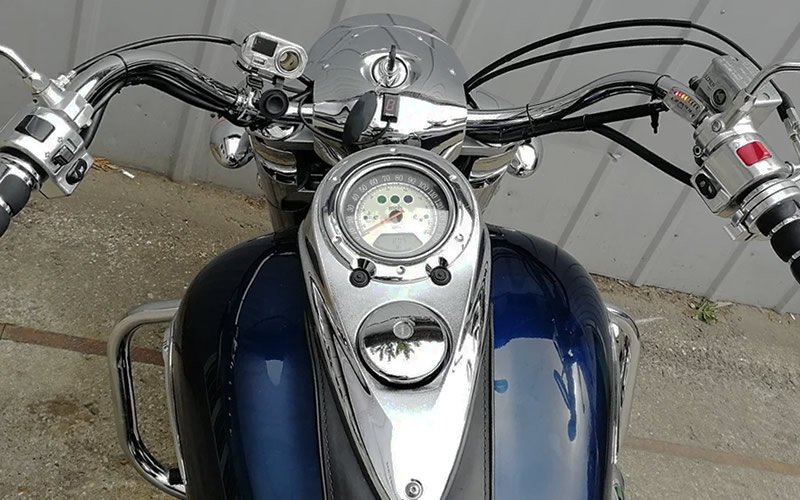Workshop manuals for self-repair of cruisers Kawasaki Vulcan
See this section in russian language
This manual is intended for independent repair and maintenance of Japanese cruiser motorcycles "Kawasaki Vulcan VN900" (codes VN900B6F/VN900D6F), which were produced from 2006 to 2024.
Description and history of Japanese motorcycles Kawasaki Vulcan
| Content: | 750/700 400 LTD 500 800 900 1500 1600 1700 2000 |
The name Vulcan has been used by Kawasaki for its line of custom or cruiser motorcycles since 1984. The initials VN are used for the versions with a V engine (the exception is the VN500, which has two inline cylinders) and range from 125 cc to 2053 cc in displacement.
Vulcan 750/700 (1984-2006)
The VN750, also known as the Vulcan 750, and the VN700, Vulcan 700 in the U.S. market, is a 750 cc cruiser motorcycle made by Kawasaki from 1985 to 2006. The Vulcan 750 was the first cruiser motorcycle and the first with a V-twin engine from Kawasaki. It was introduced in late 1984 as the 1985 model and was part of the Kawasaki Vulcan motorcycle line.

Vulcan 750, 1993 year, right view
Kawasaki introduced the 750 cc Vulcan motorcycle class in 1985 (power 66 hp, Torque 64 Nm). Due to the tariff that the U.S. imposed on the import of motorcycles from Japan over 700 cc, the initial model for the U.S. market limited the engine to 699 cc and was called the Kawasaki Vulcan 700. The tariff was revoked in 1986, and all motorcycles from that year until production ended in 2006 were 749 cc, changing its name back to Vulcan 750 for the U.S. market.

Vulcan 750, 1992 year, left view
The VN750 remained virtually unchanged throughout its 22 years of production, with only minor adjustments to components and paint schemes over the years. The VN750 was unique in its class for having a more reliable shaft drive, typically used only in larger cruiser motorcycles. The motorcycle also featured liquid cooling, DOHC, a V-twin engine capable of producing 66 hp and a torque delivery of 64 Nm that was practically flat throughout the entire RPM range, although it is known that the power published by Kawasaki was 8-10% lower than the actual measurements obtained by various laboratories on a dynamometer. The bike was configured for the rider to sit in an upright position, with a "king/queen seat" and a factory backrest for the passenger. The VN750 also had adjustable air shocks in the front and 4-way valve shocks in the rear.

Vulcan 750, 1994 year, dashboard
Vulcan 400 (1986-2004)
Kawasaki introduced the Vulcan 400 in 1986 as a beginner cruiser motorcycle. In the initial series, the Vulcan 400 featured a 398 cc liquid-cooled, parallel-twin engine, with belt final drive and a six-speed transmission. In Series 2, the Vulcan 400 had a 399 cc liquid-cooled, V-twin engine, similar to the 750 cc Vulcan model; it had chain drive and a five-speed transmission to reduce costs, and was produced in two versions: Classic and Drifter.

Vulcan 400, 1995 year, left view
Vulcan LTD (1985-1990)
The Kawasaki Vulcan LTD is a line of cruiser motorcycle models marketed between 1985 and 1990, which served as precursors to the Kawasaki Vulcan motorcycle line.

454 LTD/EN450, 1985 year, right view
The first was the Vulcan 454 LTD, a motorcycle produced from 1985 to 1990, also known as the EN450. It is the predecessor of the Vulcan 500 LTD. The engine was a derivative of the Kawasaki Ninja 900 engine, but with only 2 cylinders instead of the 4 found in the 900. The Kawasaki 900 had a displacement of 908 cc; by removing 2 of the 4 cylinders, the engine's capacity was halved, resulting in a displacement of 454 cc, hence its name. It featured liquid cooling, double overhead camshafts, and 4 valves per cylinder. This gave it significant power for an engine of its size, with a maximum RPM in the range of 10000, where it delivered 50 horsepower. The 454 is considered a good beginner motorcycle due to its low seat height and weight, as well as its efficient use of counterweights in the crankshaft to reduce engine vibration. It is also known for its excellent acceleration, demonstrating this against a Chevrolet Corvette with a large block engine, winning in acceleration from 0 to 100 km/h and in the quarter-mile (approximately 400 m) by more than 1 second.

454 LTD/EN450, 1986 year, left view
Although the 440 was its predecessor in sales of medium-sized motorcycles designed by Kawasaki, the two had almost nothing in common in terms of design, as the Kawasaki 440 had a single overhead cam and 2 valves per cylinder, was air-cooled, and produced only 27 horsepower compared to the 50 of the 454's engine. Both motorcycles were highly reliable and required low maintenance, but for different reasons: while the maintenance of the 440 was very straightforward, the 454 required almost no service because its drive to the rear wheel was via a belt.

454 LTD/EN450, 1987 year, dashboard
The Kawasaki 454 was discontinued in favor of the Kawasaki Vulcan 500 LTD in 1990, with no increase in power despite the larger displacement. The reason for the shift to the nearly identical Vulcan 500 was that production of the 908 cc Ninja 900 ceased in 1990 and was replaced by the Ninja 500, meaning there was no longer any inventory of 908 cc engines to convert into 454 cc engines. The Vulcan 500 had a very similar design to the 454, also based on its Ninja counterpart, but used the Ninja 500 engine without modification, other than a different tuning to give it more of a chopper-like performance (greater torque at low RPMs sacrificing top-end power), along with other differences such as chain drive (in later models), no tachometer, and bicycle-type spokes. Many of these changes occurred gradually as the Vulcan 500 LTD transitioned from a form very similar to the 454 (Model A) to the final form of the Vulcan 500 known as Model C.
Vulcan 500 (1990-2009)
The Vulcan 500, EN500, Vulcan 500 LTD, was introduced in 1990. It was a cruiser motorcycle, the smallest in the Vulcan lineup, created to serve as an introductory model from the LTD models to the Vulcan motorcycle line. The Vulcan 500 featured a 498 cc inline twin engine from the Kawasaki Ninja 500R. The Vulcan 500 was discontinued after the 2009 model, having been produced for nearly 20 years. The Vulcan 500 was the successor to the Vulcan 500 LTD, which was the successor to the Kawasaki 454 LTD.

500 LTD/EN500, 1997 year, right view
Vulcan 800 (1995-2006)
Two models of the Vulcan motorcycles were discontinued in 2006, alongside the introduction of the VN900 model. These were the VN800A model, introduced in 1995, which was the first of Kawasaki's modern-style models. The VN800A featured a smooth tail design, bobbed-style fenders, and a 21-inch front wheel. The second discontinued model was the VN800B (Classic), which had been introduced in 1996 and featured retro styling with full fenders and 16-inch wheels on both tires.

Vulcan 800, 1997 year, right view
Tech data:
- 805 cc liquid-cooled, 4 valves per cylinder, V-twin engine
- One 36 mm Keihin carburetor
- 5-speed transmission with optional push-button shifting
- Hidden mono-shock and rear spring

Vulcan 800, 2003 year, left view

Vulcan 800, 2002 year, dashboard
Vulcan 900 (2006-current)
The Kawasaki Vulcan 900 Classic (model VN900B) is a mid-sized cruiser motorcycle manufactured by Kawasaki, first marketed in 2006. This motorcycle follows the formula of a smaller but powerful 900 cc engine integrated into a one-size-fits-all frame, a combination also utilized by Honda, Suzuki and Yamaha in their respective cruiser lines.
As of January 2017, this model is no longer available in EU countries.

Vulcan 900, 2010 year, right view
The VN900B is a boulevard-style cruiser, resembling the Harley-Davidson Softail Deluxe or Fat Boy. It is powered by a 903 cc V-twin engine with a five-speed transmission. Overall, it measures 2.46 meters in length, has a wheelbase of 1.65 meters, and features a seat height of approximately 681 mm.
Other standard equipment includes a 20-liter fuel tank (the largest in its category), footpegs, front and rear disc brakes, electronic fuel injection, and a belt drive for final transmission. Until September 2008, the engine displacement of the Vulcan 900 range was the largest among mid-sized cruisers. This changed with the introduction of the Yamaha V-Star 950 (standard and touring models), which uses an air-cooled 942 cc engine.

Vulcan 900, 2019 year, left view
The VN900D is the touring edition of the base VN900B. The main additions to this new model are a windshield, saddlebags, and a factory-installed passenger backrest. Additionally, a studded seat replaces the standard seat.
The VN900C Custom is also available, considered the more aggressively styled sister of the VN900B. The main changes include cast alloy wheels, a larger and thinner 21-inch front tire (80/90), redesigned fenders, forward controls, a smaller headlight, and a different handlebar. The slimmer solo seat is still capable of carrying a passenger but is not as comfortable as the VN900B.

Vulcan 900, 2007 year, dashboard
Upon its unveiling, the press generally received the VN900B favorably. Many references were made to its physical presence and aesthetics, noting that it possesses features typically reserved for larger machines. The ride quality was also rated positively, as well as its ability to accommodate smaller riders due to its low seat height. Conversely, its low ground clearance due to the presence of footpegs, relatively weak rear disc brake, and, in some articles, an uncomfortable stock seat were criticized. In a broader comparison, the Suzuki C50 was identified as a potential equal to the VN900B, with the Vulcan being stronger in some areas but weaker in others.
Vulcan 1500 (1987-2008)
The Vulcan 1500 Classic features a 1470 cc liquid-cooled, SOHC, 50° V-twin engine with concentric connecting rods. It has a seat height of 27.6 inches (701 mm) from the ground, wide handlebars, and forward-set footpegs. The "Mean Streak" 1500 model had the same engine. The Vulcan 1500 Drifter was discontinued in 2005. The Vulcan 88, with its 1464 cc liquid-cooled V-twin engine, was produced from 1987 to 1999. A four-speed transmission paired with the 1464 cc "large for its time" engine offered consumers a powerful, comfortable, and relatively lightweight cruiser (just over 272 kilograms ready for travel).

Vulcan 1500, 1995 year, right view

Vulcan 1500, 1993 year, left view
Vulcan 1600 (2002-2009)
The VN 1600 is a motorcycle model series produced by Kawasaki from 2003 to 2008 in the cruiser segment. It belongs to the VN series, which has been offered since 1986, and is the successor to the VN 1500.
The VN 1600 model series is an evolution of the VN 1500 model series and replaced it upon its market introduction.

Vulcan 1600, 2004 year, left view
Key features include:
- A 5 mm longer stroke, resulting in an increase in displacement by 82 cc to 1552 cc
- Improved fuel injection
- Lower and longer design
- Dual disc brakes in the front (instead of a single disc brake on the VN 1500)
- Cast wheels (instead of spoked wheels like on the VN 1500)
- Seamless fuel tank
- Ignition switch on the tank, allowing the key to be removed in the "on" position
- External changes to the engine
- Safety cutoff switch on the side stand (when in gear)
- Tool kit in the lockable side cover

Vulcan 1600, 2007 year, right view
The VN 1600 Classic serves as the base version of the model series.
The VN 1600 Classic Tourer is largely equivalent to the VN 1600 Classic but features a number of additional standard equipment elements:
- Crash bars in the front and rear
- Windshield
- Wind deflectors
- Passenger backrest (Sissybar)
- Painted hard-shell saddlebags
Additionally, the VN 1600 Classic Tourer was delivered with a modified exhaust system that allows for the necessary space for the saddlebags.

Vulcan 1600, 2008 year, dashboard
The VN 1600 Mean Streak is the sportier variant of the model series. The main differences from the VN 1600 Classic include:
- Increased engine power compared to the Classic: 54 kW (73 hp)
- Redesigned tank, fenders, and handlebars
- Upside-down fork
- 17" wheels
- Relocation of the instruments from the handlebars to the triple clamp
- Tachometer
- Increased seat height (700 mm)
Vulcan 1700 (2009-current)
The Kawasaki Vulcan 1700 is a cruiser motorcycle produced by Kawasaki Heavy Industries, introduced in 2009 as part of the Vulcan series. Designed to combine classic cruiser aesthetics with modern technology and performance, the Vulcan 1700 has garnered a reputation for its powerful engine, comfortable riding experience, and distinctive styling.

Vulcan 1700 Voyager, 2011 year, right view
The Vulcan 1700 is powered by a 1700 cc liquid-cooled, four-stroke, V-twin engine. This engine configuration is known for its strong low-end torque, delivering approximately 147 N·m of torque at 3500 rpm. The motorcycle features a six-speed transmission, which provides smooth gear shifts and enhances highway cruising capabilities. The Vulcan 1700 is available in several variants, including the Vulcan 1700 Classic, Vulcan 1700 Classic LT, and Vulcan 1700 Voyager, each tailored to different riding preferences.

Vulcan 1700 Classic LT, 2012 year, right view
The Vulcan 1700 showcases a classic cruiser profile, characterized by its low-slung seat height, wide handlebars, and elongated fenders. The seat height is approximately 706 mm, making it accessible for a variety of riders. The motorcycle is equipped with a plush, well-cushioned seat designed for comfort during long rides.

Vulcan 1700 Classic, 2014 year, front view
Aesthetically, the Vulcan 1700 incorporates chrome accents and a retro-styled headlamp, blending traditional cruiser elements with modern touches such as LED lighting. The bike features a large analog speedometer combined with a digital display that includes a tachometer, fuel gauge, and trip meter, providing riders with essential information at a glance.

Vulcan 1700 Classic LT, 2009 year, left view
The Vulcan 1700's engine is designed with a focus on delivering a smooth and powerful ride. The use of digital fuel injection ensures optimal fuel delivery and efficiency, while the belt drive system offers low maintenance and a quieter operation compared to chain drives. The motorcycle's rigid frame and low center of gravity contribute to its stability and handling, allowing for confident maneuverability in various riding conditions.

Vulcan 1700 Voyager, 2015 year, dashboard
Variants:
- Vulcan 1700 Classic: This variant emphasizes traditional cruiser styling with a minimalist approach, featuring a classic design and comfortable ergonomics.
- Vulcan 1700 Classic LT: The LT version adds touring features such as a windshield, saddlebags, and a passenger backrest, making it more suitable for long-distance travel.
- Vulcan 1700 Voyager: This variant is designed for touring enthusiasts, offering additional comfort features, advanced electronics, and a more substantial fairing for wind protection.
Vulcan 2000 (2004-2010)
Based on and built on the same frame, the Vulcan 2000, the Classic, and the Classic LT have only minor differences between them. The most apparent is the insect-eye style headlight that projects forward, introduced in the base model Vulcan VN2000A in 2004. This front light was the only one offered until the introduction of the Vulcan Classic VN2000D in 2006, which featured a more traditional headlight. Also in 2006, the Vulcan Classic LT VN2000F was released; it had a similar appearance to the Classic model but included saddlebags, a windshield, full footpegs, and a passenger backrest.

Vulcan 2000, 2007 year, right view
Specifications:
- 2053 cc V-twin engine at 52°
- 191 Nm of torque @ 3,000 rpm
- 116 hp @ 5,000 rpm
- Belt drive
- Electronic engine control unit (ECU) with fuel injection
- Forged pistons and alloy connecting rods
- Steel double cradle frame with box-section. Individual reinforcement column for greater strength
- Dual 300 mm disc brakes with 4-piston calipers in the front and single disc with 2-piston calipers in the rear

Vulcan 2000, 2008 year, left view

Vulcan 2000, 2005 year, dashboard
- Information for owner
- Introduction to manual
- Maintenance
- Engine and systems
- Engine repair
- Fuel system (DFI)
- Cooling system
- Lubrication system
- Transmission
- Running gear and frame
- Frame and hinged elements
- Front suspension and handlebar
- Rear suspension
- Brake system
- Wheels and tires
- Electric equipment
- Equipment and devices
- Lighting and lamps
- Starting and charging system
- Ignition system
- Electrical circuits
